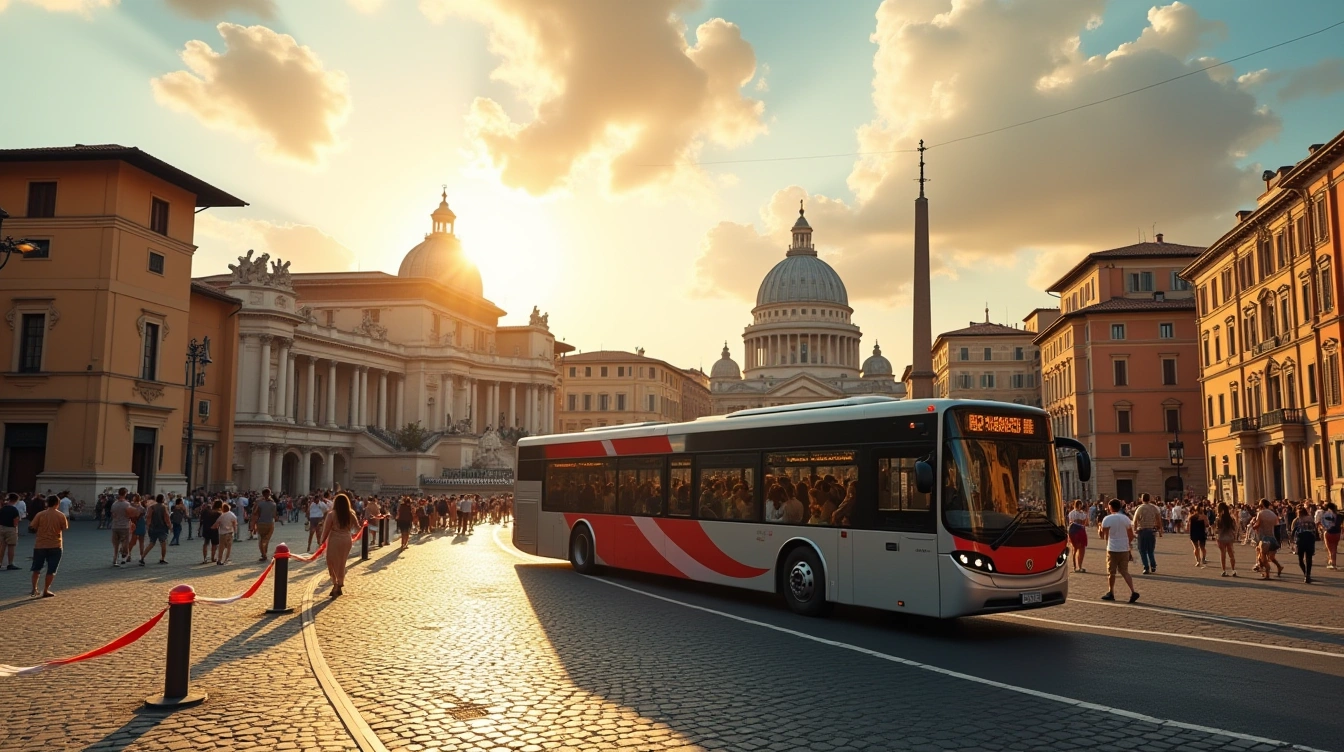Why Rome Travelers Choose Turbopass: A Comprehensive Review of the Rome City Pass
Rome welcomed over 35 million visitors in 2024 according to the Italian National Tourism Board, making efficient sightseeing more crucial than ever. The Turbopass Rome promises skip-the-line access to major attractions, transportation coverage, and significant savings for travelers tackling the Eternal City’s must-see landmarks. How can you maximize your Roman holiday while avoiding those notorious queues at the Colosseum and Vatican? Check out your guide to rome the turbopass review for complete insights into this popular city pass option.
Skip-the-Line Access: Your Time-Saving Solution at Rome’s Top Attractions
Rome’s most popular attractions draw millions of visitors annually, creating substantial waiting times that can consume hours of your precious vacation. During peak season, standard entry lines at the Colosseum regularly stretch beyond two hours, while Vatican Museums queues can extend up to three hours during busy periods.
Additional reading : Uncover the wonders of british engineering history through engaging interactive workshops
Skip-the-line access transforms your Roman experience by eliminating these frustrating delays. At the Colosseum, you’ll bypass crowds and enter directly through dedicated entrances, saving typically 90-120 minutes. The Vatican Museums become equally accessible, with priority entry reducing your wait from hours to mere minutes.
The Panthéon, though free to enter, often requires 45-60 minutes of queuing during tourist season. With skip-the-line privileges, you walk straight inside this architectural marvel. This time-saving advantage becomes particularly valuable when you consider Rome’s compact tourist schedule – those saved hours translate into visiting additional sites or enjoying leisurely Roman meals.
Also read : Top tips for maximizing savings with the visit London pass
Beyond time savings, skip-the-line access reduces travel stress and allows for better itinerary planning. You can confidently schedule multiple attractions in a single day, knowing that unpredictable queue lengths won’t derail your carefully planned Roman adventure.
Cost Analysis: When This City Pass Delivers Maximum Value
The Turbopass Rome becomes profitable when you visit at least 3-4 major attractions per day. Let’s break down the numbers to determine your ideal duration and investment threshold.
Here’s the cost breakdown compared to individual ticket prices:
- 24-hour pass (€69): Profitable if visiting Colosseum (€18) + Vatican Museums (€17) + Castel Sant’Angelo (€15) + one museum (€12-15) = €62-65 individual cost
- 48-hour pass (€89): Break-even point at 5-6 attractions over two days, saving €15-25 compared to individual tickets
- 72-hour pass (€109): Maximum value for active tourists visiting 8+ attractions, potential savings of €40-60
The pass delivers maximum value for visitors who prioritize skip-the-line access at premium attractions. Even if cost savings are minimal, the time saved during peak season (avoiding 1-2 hour queues) often justifies the investment.
Budget-conscious travelers should target the 48-hour option, which offers the best balance between cost and flexibility for most Rome itineraries.
Complete Attraction Portfolio: What’s Included in Your Pass
Le Turbopass Rome ouvre les portes de plus de 60 attractions réparties dans tous les quartiers emblématiques de la capitale italienne. Cette couverture exhaustive vous permet d’explorer la Rome antique avec le Colisée, le Forum Romain et les Thermes de Caracalla, tout en découvrant la splendeur baroque de la Fontaine de Trevi et de la Place d’Espagne.
Votre pass inclut également l’accès aux musées du Vatican et à la Chapelle Sixtine, véritables joyaux de l’art Renaissance. Les amateurs d’histoire apprécieront les Musées Capitolins, le Palazzo Altemps et la Crypte Balbi, qui retracent l’évolution de Rome à travers les siècles.
Au-delà des sites incontournables, le pass couvre des expériences plus confidentielles comme les souterrains de San Clemente, l’Opéra de Rome ou encore les jardins de Villa Borghese. Cette diversité garantit un programme riche, que vous soyez passionné d’archéologie, d’art sacré ou de culture contemporaine romaine.
Mobile Convenience and Digital Features That Enhance Your Visit
L’application mobile du Turbopass transforme votre smartphone en guide personnel intelligent. Une fois téléchargée, elle fonctionne entièrement hors ligne, vous permettant d’explorer Rome sans vous soucier des frais de roaming ou de la couverture réseau.
La fonction de géolocalisation intégrée vous guide précisément vers chaque attraction, calculant automatiquement les temps de trajet à pied ou en transport public. Plus besoin de jongler entre plusieurs applications : tout est centralisé dans une interface intuitive.
Les guides audio professionnels enrichissent votre visite de chaque monument. Disponibles en plusieurs langues, ces commentaires d’experts vous révèlent les secrets historiques et anecdotes que vous ne trouverez pas dans les guides traditionnels.
Le planificateur d’itinéraire intelligent optimise votre parcours selon vos préférences et le temps disponible. Il suggère les meilleurs créneaux pour éviter les foules et maximise votre temps de visite. Cette autonomie digitale vous libère des contraintes des visites guidées traditionnelles tout en vous offrant une expérience enrichie et personnalisée.
How This Pass Compares to Other Rome City Pass Options
Rome’s tourism market offers several city pass alternatives, but the Turbopass stands out through its comprehensive approach to visitor convenience. While the traditional Roma Pass focuses primarily on museums and public transport, Turbopass addresses the complete tourist experience with priority access to Rome’s most coveted attractions.
The Roma Pass, priced at €38.50 for 48 hours, includes free public transport and entry to two attractions, plus discounts on others. However, it doesn’t guarantee skip-the-line access to the Colosseum or Vatican Museums during peak seasons. Turbopass eliminates this uncertainty by securing guaranteed time slots for major attractions, preventing the disappointment of sold-out venues.
Other alternatives like individual attraction tickets often cost more when purchased separately. A standard Colosseum ticket costs €18, Vatican Museums €17, and St. Peter’s Basilica dome climb €10. Turbopass bundles these experiences at a lower combined rate while adding convenience features like mobile vouchers and flexible cancellation policies.
The key differentiator lies in Turbopass’s focus on time efficiency. While competitors may offer slight cost savings, they rarely match the seamless experience of having all major attractions pre-booked with confirmed access times, making it particularly valuable for visitors with limited time in Rome.
Your Questions About Turbopass Rome Answered

Is the Turbopass Rome actually worth the money in 2025 ?
Yes, if you plan to visit at least 3-4 major attractions. The pass becomes profitable when comparing individual ticket prices, especially with skip-the-line access included for premium sites.
What attractions are included in the Turbopass Rome?
The pass covers over 60 attractions including Colosseum, Roman Forum, Palatine Hill, Capitoline Museums, Castel Sant’Angelo, and numerous churches, plus free public transport within Rome.
How much does the Turbopass Rome cost and which duration should I choose?
Prices range from €69 (72 hours) to €139 (6 days). Choose based on your stay length: 72 hours for weekend trips, 6 days for comprehensive exploration.
Does the Turbopass Rome include skip the line access to the Colosseum and Vatican?
Yes for Colosseum and Roman Forum. However, Vatican Museums require separate booking as they’re not included in any Rome city pass due to independent management.
What’s the difference between Turbopass Rome and other Rome city passes?
Turbopass offers the most comprehensive coverage with transport included, while Roma Pass focuses on museums. Omnia Card combines Vatican access but costs significantly more overall.











